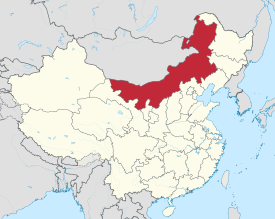
How to Get to Inner Mongolia
Inner Mongolia, a vast autonomous region in northern China, beckons travelers with its endless grasslands, captivating deserts, and rich nomadic culture. Whether you yearn to ride horses across the steppe, witness the grandeur of the Gobi Desert, or immerse yourself in Mongolian traditions, reaching Inner Mongolia is the first step to an unforgettable adventure. This comprehensive guide will navigate you through the various transportation options, ensuring a smooth journey to this enchanting land.
Flights to Inner Mongolia
Soaring through the skies is arguably the most efficient way to reach Inner Mongolia, especially for those traveling from distant cities or seeking to maximize their time. With over 10 public airports scattered across the region, you'll find several gateways to your Mongolian escapade. Here are the most frequently used airports by travelers:
| Airport | City | Airlines Served | Notes |
|---|---|---|---|
| Hohhot Baita International Airport (HET) | Hohhot | Air China, China Eastern, China Southern, Hainan Airlines, and more. | The busiest airport in Inner Mongolia, serving the regional capital. |
| Baotou Erliban Airport (BAV) | Baotou | Air China, China Eastern, Shandong Airlines, and more. | A major airport in western Inner Mongolia, connecting to key cities in China. |
| Hailar Dongshan Airport (HLD) | Hailar | Air China, China Eastern, Juneyao Airlines, and more. | The gateway to Hulunbuir, renowned for its picturesque grasslands. |
| Manzhouli Xijiao Airport (NZH) | Manzhouli | Air China, China Eastern, and more. | Connects to major cities in northern China and Russia. |
Flight Experiences and Tips:
Flying to Inner Mongolia offers breathtaking views, especially when approaching the region's vast grasslands and desert landscapes. Keep your camera ready for stunning aerial perspectives. To secure the best deals on flights, consider traveling during the off-season (spring or autumn) or booking in advance. Additionally, utilizing flight comparison websites and subscribing to airline newsletters can help you snag affordable fares.
Other Transportation Options
While flying is the most convenient option for long-distance travel, alternative modes of transportation exist for reaching Inner Mongolia or traversing within the region:
Train Travel:
Inner Mongolia is well-connected by rail, offering a scenic and budget-friendly alternative to air travel. Major cities like Hohhot and Baotou have railway stations with connections to Beijing, Shanghai, Xi'an, and other significant destinations in China. Train journeys provide a unique opportunity to witness the gradual transition of landscapes, from bustling metropolises to the vast steppes of Inner Mongolia.
Long-Distance Buses:
Buses operate between major cities and towns in Inner Mongolia and neighboring provinces. While this option might be less comfortable than flying or taking the train, it offers an affordable way to travel, especially for shorter distances.
Self-Driving:
Embarking on a self-drive adventure through Inner Mongolia can be an exhilarating experience, allowing for greater flexibility and off-the-beaten-path exploration. However, it's crucial to be prepared for long driving distances, limited services in remote areas, and the possibility of challenging road conditions, especially during winter. Ensure your vehicle is in excellent condition, pack ample supplies, and check weather forecasts before embarking on your road trip.
Travel Tips for Inner Mongolia:
- Best Time to Visit: The ideal time to experience the beauty of Inner Mongolia is during the summer (June to August) when the grasslands are lush and vibrant. However, be prepared for potential crowds during peak season.
- Visa Requirements: Ensure you have the necessary visa to enter China. Most nationalities require a tourist visa, which can be obtained from Chinese embassies or consulates worldwide.
- Language: While Mandarin Chinese is the official language, Mongolian is widely spoken in Inner Mongolia. Learning a few basic Mongolian phrases can enhance your cultural immersion and facilitate communication with locals.
- Respect Local Customs: Mongolian culture is deeply rooted in hospitality and respect. When interacting with locals, remember to be mindful of their customs and traditions. For instance, offering gifts with both hands is considered polite, and it's customary to sip a drink offered to you, even if just a small amount.
- Pack Appropriately: Inner Mongolia experiences a continental climate with distinct seasons. Pack layers of clothing to accommodate temperature variations, especially if traveling during spring or autumn. Sturdy footwear is essential for exploring grasslands and deserts, while a hat and sunglasses are crucial for sun protection.
References:
- Lonely Planet. (2023). Inner Mongolia. Retrieved from [https://www.lonelyplanet.com/china/inner-mongolia](https://www.lonelyplanet.com/china/inner-mongolia)
- Travel China Guide. (n.d.). Inner Mongolia Travel Guide. Retrieved from [https://www.travelchinaguide.com/cityguides/innermongolia.htm](https://www.travelchinaguide.com/cityguides/innermongolia.htm)
FAQs:
1. What is the best way to get around Inner Mongolia?
The best way to get around Inner Mongolia depends on your itinerary and budget. Renting a car offers flexibility, while hiring a driver is ideal for covering larger distances or venturing into remote areas. Public transportation, such as buses, is available but might have limited schedules and routes. In major cities, taxis are readily available for shorter trips.
2. Is it safe to travel to Inner Mongolia?
Inner Mongolia is generally a safe destination for travelers. The crime rate is relatively low, and the local people are known for their hospitality. However, it's always advisable to exercise common sense, safeguard your belongings, and be aware of your surroundings, especially in crowded areas or at night.
3. What currency is used in Inner Mongolia?
The official currency of China, including Inner Mongolia, is the Chinese Yuan (CNY), often abbreviated as RMB (Renminbi). Major credit cards are accepted in larger hotels, restaurants, and department stores. However, it's advisable to carry some local currency, especially when traveling to smaller towns or rural areas where cash is preferred.
More article references: train from beijing to inner mongolia
note: This return of all, without the author's permission, may not be reproduced